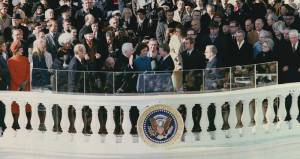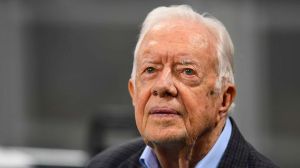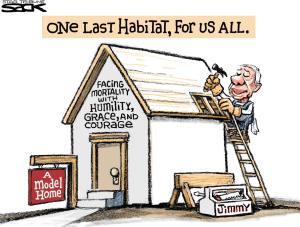
 The brothers aren’t getting any younger. Pete Zaworonok is 77. His younger brother, Raymond is 72. Neither are in the best of health these days. So retirement looms, with Pete planning to relocate permanently back to his longtime home near Nelson, British Columbia, while Raymond’s home is in Calgary. Until recently, the brothers would often takes turns commuting back to their Alberta and British Columbia homes for months at a time, while the other brother remained in Thompson minding the store, Crazy Petes, their legendary eclectic small-town hardware-like store, at the corner of Hayes Road and Seal Road, with one of this, and two of that. On rare occasions, I’d come into the store while the brothers were together during a brief overlap.
The brothers aren’t getting any younger. Pete Zaworonok is 77. His younger brother, Raymond is 72. Neither are in the best of health these days. So retirement looms, with Pete planning to relocate permanently back to his longtime home near Nelson, British Columbia, while Raymond’s home is in Calgary. Until recently, the brothers would often takes turns commuting back to their Alberta and British Columbia homes for months at a time, while the other brother remained in Thompson minding the store, Crazy Petes, their legendary eclectic small-town hardware-like store, at the corner of Hayes Road and Seal Road, with one of this, and two of that. On rare occasions, I’d come into the store while the brothers were together during a brief overlap.
Back 10 years ago, Jonathon Naylor, then the editor of The Reminder in Flin Flon and a freelancer for the Winnipeg Free Press, wrote a piece for the Free Press that nicely captured what Pete and Crazy Petes is all about:
“Need a campfire tea kettle or some high-end embroidery thread? How about a home potato chipper or military toys you thought were banned?” Naylor wrote. “A movie poster from 1991’s Teenage Mutant Ninja Turtles II or fishing tackle that looks designed to snag a whale?
“It’s all here, along with gas and a car wash,” Naylor wrote on June 20, 2013.
Pete, who was born in Germany, was living in Edmonton when, in 1967, he accepted a job as a technologist for INCO, now Vale, here in Thompson. After a decade, he left INCO to go into business for himself, running his own insulating company before operating what Raymond June 7 referred to as the brothers’ “three profit centres”: the original car wash and gas bar, along with the store he added to them to make a business trio in 1979. The car wash wasn’t open last Wednesday as a water line was still frozen up, Raymond said. Pete actually was in Thompson, but home recuperating from some aorta trouble a few months ago, he added. Raymond has had some prostate trouble of his own.
Truth be told, Pete and Raymond are two of the most creative business guys that I have ever met. When it came to customer loyalty cards, such as Aeroplan and PC Optimum Points Reward cards, Crazy Petes had the broadest definition of what constituted groceries than it has been my pleasure to discover.
Pete one time explained his marketing strategy to me by way of an illustration. He had some old cowboy belt buckles quite literally gathering dust on the shelves for years, not selling at all. One day, he simply doubled their price and they started to sell like hotcakes. The store has a collection of local indigenous music cassette tapes and CDs you won’t find anywhere else.
I have done my bit over the years to promote the wonders of Crazy’s Petes far and wide. With mixed results, I admit. In April 2022, the former University College of the North (UCN) Thompson campus librarian, Monica Mun, came back one day after making a trip with a pet to the vet, and mentioned to my then boss, former library technician Andrew Conner, that she had just seen lots of RCMP cruisers outside Crazy Petes store. “Isn’t that the place John was talking about?” she asked Andrew. At that point, Andrew may well have been advised to reply, “John who?” But he didn’t. Andrew, hailing from the Alex Murdaugh Lowcountry of South Carolina, shares something of that outlaw streak, or at least admiration for same, that I admittedly have.
I suspect we’re not alone. Hence the sympathetic notoriety enjoyed by some bank robbers, including John Dillinger, Clyde Barrow, Bonnie Parker, Butch Cassidy, Harry Alonzo Longabaugh, better known as the Sundance Kid, Pretty Boy Floyd, and Edwin Alonzo Boyd, or say someone like D.B. Cooper, who with his audacious skyjacking, jumped into history on Nov. 24, 1971 – the day before American Thanksgiving – with several parachutes and $200,000 in $20 bills from of Northwest Orient Airlines Flight 305, a Boeing 727 jetliner flying over the Pacific Northwest, en route from Portland, Oregon to Seattle, Washington. Cooper, an alias, disappeared into the late autumn, as he bailed out into the rainy night via the plane’s rear stairway, which he lowered himself, somewhere near the Washington-Oregon boundary in Washington State, probably near Ariel in Cowlitz County, or possibly around Washougal or Camas in Clark County. Never to be seen again.
Any resemblance to Pete and Raymond, of anyone mentioned here, is, of course, coincidental, and if necessary, fictional, too.
Raymond says there have been some potential buyers sniffing around, wanting to take a look at the books, but no serious offers as yet. It strikes me as unlikely that a new buyer would replicate or maintain Crazy Petes inventory, all inseparable, I suspect, from the Zeitgeist that is the Zaworonok brothers.
Pete and Raymond.
Gone Fishin.’
Almost.
You can also follow me on Twitter at: https://twitter.com/jwbarker22


